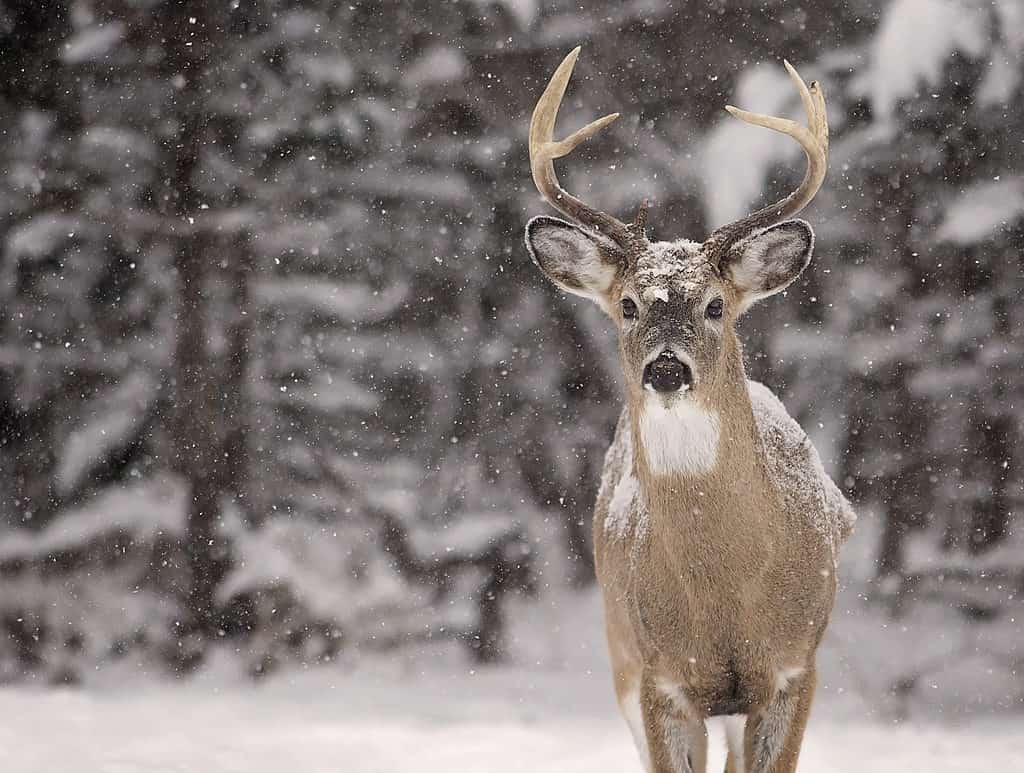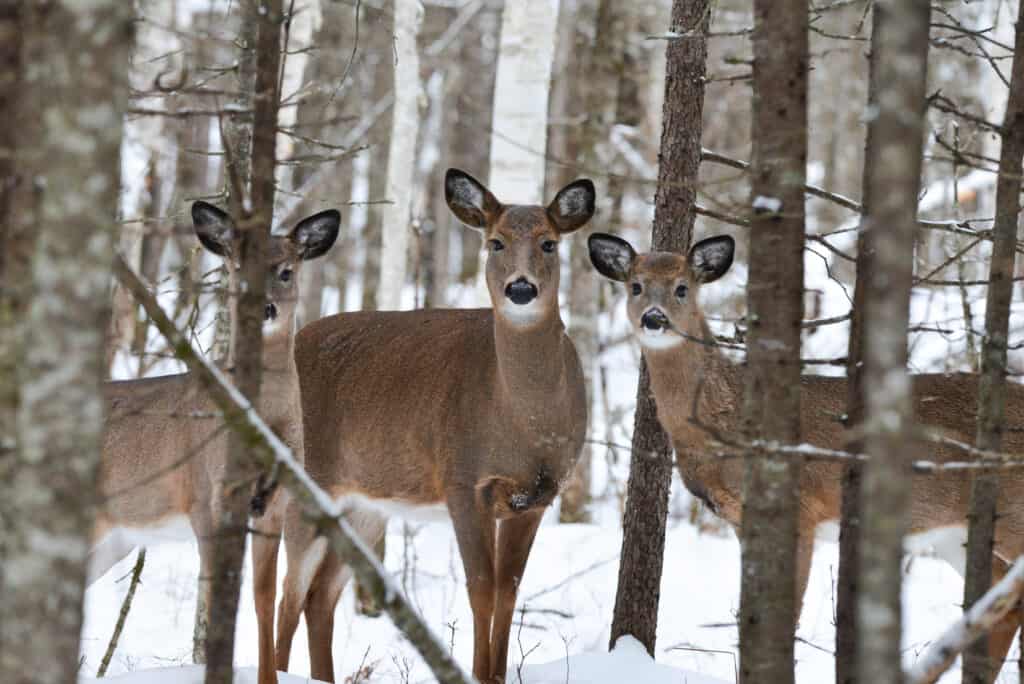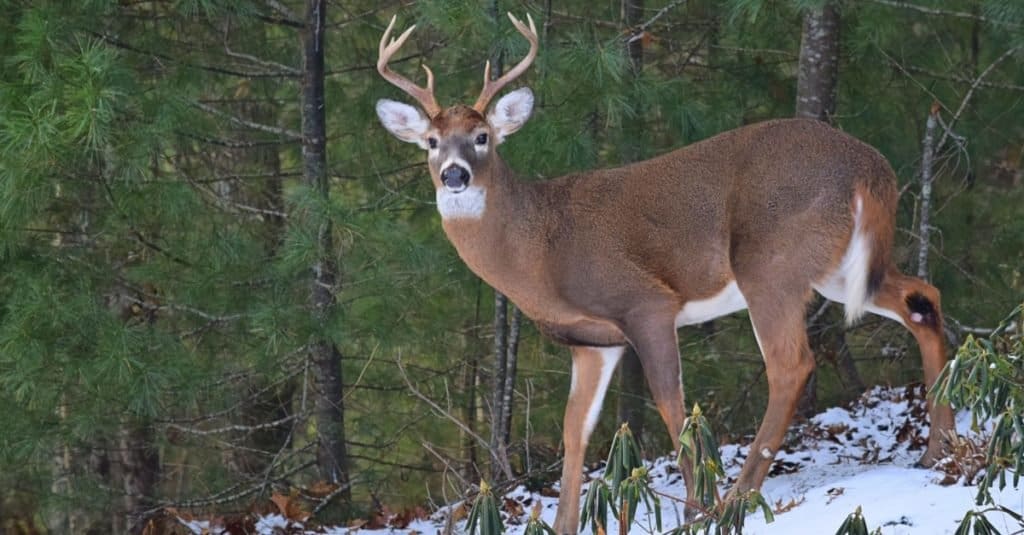Many people see the white-tailed deer as a nuisance. After all, because humans have encroached onto the habitat of this deer, the deer end up becoming pests. Deer can often feed on gardens or fledgling trees that people are trying to grow and cause a lot of damage. They also easily become overpopulated.
Deer hunting can help with the overpopulation problem. Additionally, a hunter can feel a sense of accomplishment when killing a particularly large white-tailed deer. If you want to know more about the largest white-tailed deer ever caught in Colorado, keep reading!

Many people see the
white-tailed deer
as a nuisance.
©iStock.com/Lynn_Bystrom
Background Information On The White-tailed Deer
White-tailed deers are the smallest among North American deer. They are generally seen between southern Canada and South America, although you would be hard-pressed to find one in the southwestern United States, Hawaii, or Alaska.
Habitat And Behavior
These deer typically live in wooded areas, although they can also thrive in farmlands, deserts, and swamps. For any individual deer, the animal will typically have a home range that is less than one square mile.
If a doe does not have fawns, she will typically be solitary. Male bucks sometimes live in small groups, but they will be solitary during mating season. If a mother has fawns, she will typically be with them.
White-tailed deer have many natural predators. Young deer are particularly vulnerable to coyotes and bobcats. Humans would sometimes introduce mountain lions and gray wolves into deer populations to curb them when these deer would become overpopulated.
Nowadays, the main predators of these animals are humans and dogs. When deer become overpopulated, food can become scarce, and many can starve to death. In many suburban and urban areas, hunting is not allowed, making it more likely that deer populations will become too big. Hunters can be important in controlling deer populations in rural areas.
Deer populations can also be affected by parasites and diseases. They are more likely to get sick and die at any age in the winter. The structures of their hooves and legs make it difficult for them to move very quickly through the snow and ice, so it is easier to become prey to dogs and other predators.
However, generally, white-tailed deer are very quick. They can run up to 30 miles per hour and can usually leap and swim as well.
Diet

In terms of diet, white-tailed deer are herbivores.
©iStock.com/steverts
In terms of diet, white-tailed deer are herbivores. These animals typically graze on available plant foods. They are able to digest leaves, grass, alfalfa, corn, nuts, fruits, twigs, and even fungi. Even though you may occasionally see them in the daytime, they are primarily nocturnal animals.
The diet of the white-tailed deer changes depending on what is available in the surroundings. In the spring and summer, they mostly eat green plants. During the fall, when green leaves are less available, they tend to eat corn and nuts, such as acorns. In the winter, they eat twigs and buds of woody plants.
This animal is classified as a ruminant, meaning that it has a stomach with four chambers. In the first two chambers, food mixes with bile to form cud. The deer regurgitates this cud, and then rechews and swallows it. Then, the cud goes to the last two chambers of the stomach and then passes through the rest of the deer’s digestive system.
The fact that the deer is a ruminant allows this animal to eat wood and other foods that most animals wouldn’t be able to digest.
Appearance And Size
The white-tailed deer is typically grayish brown in the winter and brown or tan in the summer, with white patches on different parts of its body.
The male of the species has antlers, which is the parameter judges use to determine the size of the animal when captured by a hunter. They shed their antlers between January and March and grow them out again in April or May.
These deer can actually vary quite a bit in size, being largest in cold temperate climates (like much of Colorado). Male white-tailed deer (bucks) typically weigh 150 to 250 pounds, with the females (does) weighing 100 to 150 pounds. These animals typically stand between 36 and 42 inches tall at the shoulder.
The largest bucks can be as tall as 42 inches at the shoulder and can weigh up to 400 pounds or 180 kilograms.
White-tailed Deer In Colorado
The white-tailed deer populations in Colorado are mostly located in the eastern part of the state. However, there are a few in the central mountain areas as well.
In recent years, herds of white-tailed deer have been growing between the Front Range and the Kansas border. State wildlife officials have thus started to specifically encourage the hunting of these deer, in order to prevent the populations from expanding.

The white-tailed deer populations in Colorado are mostly located in the eastern part of the state.
©Rebecca C. Photography/Shutterstock.com
The Largest White-tailed Deer Ever Caught In Colorado
The measurements for the hunted white-tailed deer might be somewhat confusing because they have nothing to do with the height or weight of the deer’s body. Instead, judges utilize a system of antler scoring. Measurements are taken of the deer’s antlers at several different points. Of course, this disqualifies any doe from officially being the largest white-tailed deer caught.
Antlers can be either typical (symmetrical) or non-typical (asymmetrical). The measuring process for symmetrical antlers is much simpler. Before judges can score the rack, it needs to have air dried for a minimum of 60 days and can’t have any artificially replaced components or a broken skull plate.
To be listed among the records, the minimum score for a typical white-tailed deer would have to be 170. The current record for the largest typical whitetail deer ever caught in Colorado is 192 1/8. Eddie L. Kinney achieved this in 2003.
However, the largest non-typical whitetail deer ever caught in Colorado had a score of 258 2/8. This makes this the largest white-tailed deer ever caught in Colorado. Michael J. Okray achieved this kill in 1992, and Bass Pro Shops took ownership of the deer.

As far as we know, the largest white-tailed deer ever caught was shot by a bowhunter.
©Michael Sean OLeary/Shutterstock.com
The Largest White-tailed Deer Ever Caught In The World
As far as we know, the largest white-tailed deer ever caught was shot by a bowhunter. John Annett of Ontario, Canada broke this record in 1977. In this case, the judges measured the buck by weight rather than antler dimensions. The buck weighed in at 431 pounds on government-certified scales, indicating that it likely weighed over 540 pounds when it was alive.
Where Is Colorado Located On A Map?
Colorado is in the mountain west region of the United States and encompasses most of the southern Rocky Mountains. It is part of the four corners region, the only location in the United States where four states meet – in the southwest with Utah to the west, Arizona to the southwest, and New Mexico to the south. Colorado is also bordered by Kansas to the east, Nebraska to the northeast, Oklahoma to the south, and Wyoming to the north.
The photo featured at the top of this post is © Herbie Pabst/Shutterstock.com
Thank you for reading! Have some feedback for us? Contact the AZ Animals editorial team.






